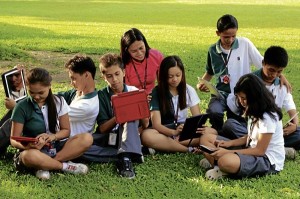University program scores e-success

STUDENTS of Foundation University (FU) are not just being hip by using their iPads in class. They have been using them instead of thick, paper-bound books since 2010, and studies show the iPad program has helped improve the students’ performance by 6 to 10 percent. PHOTO BY HERSLEY VEN CASERO/CONTRIBUTOR
DUMAGUETE CITY—Two years ago, parents were hesitant to the plan of Foundation University (FU) to use a popular tablet in lieu of using thick, paper-bound books. Their fears ranged from the cost of purchasing an iPad to how to safeguard the units.
Now, the iPad program not only improved the students’ academic performance but also caught the curiosity of other schools and universities interested in adopting the innovation.
Officials of FU, which is recognized as the pioneer in the country in using the iPad in the classroom, have been invited to speak about the iPad experience in schools in Dumaguete City in Negros Oriental, Surigao and Iloilo.
“The classroom of today, especially at Foundation University, is different from the classrooms we have been so used to,” said FU High School principal Cecil Arbas.
Instead of heavy books, students now bring textbooks in electronic format, or e-books, in their light iPads.
The iPad is required for students from Grade 4 to senior high in FU. Next year, some college courses will have their own versions of the program.
Victor Vicente Sinco, FU vice president for finance and administration, recalled the initial resistance to the iPad program when it was introduced in 2010.
“Parents’ concerns ranged mostly on the cost of the iPads and how to safeguard the units,” he said.
Some were also apprehensive about the possibility that the device might break when accidentally dropped by child users. This disappeared after Sinco, in one Parents-Teachers Association meeting, intentionally dropped his iPad to the floor before the amazed parents.
“The iPad is no longer the tool of the future. It is being used in many schools throughout the world today,” Sinco said.
Studies made by Arbas and FU Elementary School principal Fe Villas on the use of iPads have shown that students are actually improving their performance by 6 to 10 percent.
“We are happy to see this big change in our students’ scores,” Villas said.

WITH some tips online and their sheer curiosity, FU students have taken their iPads beyond school work. Some edit videos while others create their own apps. PHOTO BY HERSLEY VEN CASERO/CONTRIBUTOR
One reason is that the students themselves say the iPads make the subjects interesting. Many times, they find other uses for their iPads, thanks to the extensive WiFi connection all around the two FU campuses.
Arbas and Villas said students sometimes go to other websites or play games during classes. “But the students are smart and could hide their games from us,” Villas said.
Not to be outdone, the teachers started holding learning circles among themselves to discuss iPad techniques and share best practices. Soon, more teachers knew how to operate iPads by heart.
“Sometimes, we ask our students how they do certain tricks, like how to put the bar above the ‘n’ for the ñ character,” Villas said.
Mark Espedilla, father of
6-year-old Kurt, said that even though his son was not required to bring an iPad, he knows more about using it than his parents.
“When my wife, who is an elementary teacher at FU, asks me how to do certain things on the iPad, I tell her, ‘Ask Kurt,’” Espedilla said.
Some students are not just better than their teachers or parents when it comes to iPad tricks, they now make videos edited from iPads. Some of them, like Carlo Matheous Simpao, 14, are actually into making iPad apps.
Simpao uploaded his app named “Pad Paper” on July 15. This free application was downloaded 1,900 times in two weeks. “It’s a simple note-taking app,” the proud Carl said of his creation.
This app resulted from Simpao’s interest in the iPad. “I made the Pad Paper app to see if I could make an app similar to what I had in my iPad. It took me two months to make it, mostly from self-study and from getting some pointers online,” he beamed.
Still, the temptation to use iPads for logging on to Facebook or watching some distracting websites is there.
“But we set policies in our school for the use of iPads and we also talked to the parents about it,” Arbas said.
To enable parents to watch over their children and ensure that the iPads are properly used, FU also teaches parents and even grandparents how to use the iPad.
“Not a few parents are known to tell their kids, ‘on school days, the iPad is yours, on weekends, it’s mine!’” Arbas said.
While the iPad is making learning easier and fun for students, it also means more work for the teachers, especially in the early stages of implementation.
“Technology demands more time than the former ways of doing things,” Villas admitted.
Arbas said that using iPads also makes teachers available to students even beyond class hours. “Sometimes, we get e-mails from our students at midnight so we have to answer them,” she said.
Arbas and Villas continue to try to inspire their teachers to keep on learning, believing that it takes a good teacher to handle technology inside the classroom.